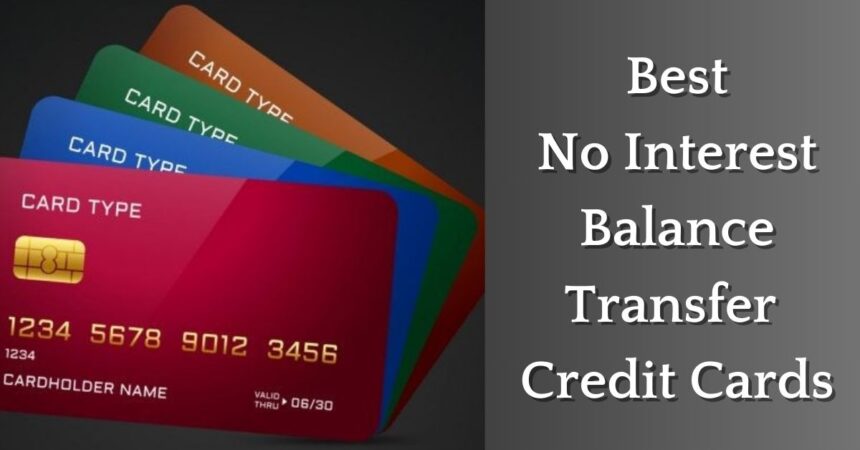1. Introduction to Best No Interest Balance Transfer Credit Cards
What Are No Interest Balance Transfer Credit Cards?
No interest balance transfer credit cards are financial products that allow consumers to transfer existing credit card debt to a new card with a 0% introductory APR (Annual Percentage Rate) for a specified period. This can significantly reduce the amount of interest a cardholder pays on their debt, making it easier to pay off the balance.
Benefits of No Interest Balance Transfer Credit Cards
- Interest Savings: The primary benefit is the potential savings on interest payments during the introductory period.
- Debt Consolidation: These cards often allow users to consolidate multiple debts into one manageable monthly payment.
- Financial Breathing Room: The 0% APR period provides cardholders with time to pay down their principal balance without accruing additional interest charges.
Recognizing the Fine Print: Things to Watch Out for
While no interest balance transfer credit cards offer attractive benefits, it’s crucial to understand the fine print:
- Balance Transfer Fees: Most cards charge a fee for balance transfers, typically 3%-5% of the transferred amount.
- Regular APR: Know what the APR will revert to after the introductory period ends.
- Credit Score Requirements: Ensure your credit score meets the card issuer’s requirements to qualify for the 0% APR offer.
2. Exploring the Features of No Interest Balance Transfer Credit Cards
Introductory APR Period
The length of the introductory 0% APR period varies among cards. Some may offer 12 months, while others extend up to 21 months. You have more time to pay off your loan without incurring interest if the period is longer.
Balance Transfer Fees
Balance transfer fees can add up quickly, so it’s important to factor this into your overall savings calculation. Some cards offer no balance transfer fees, but these are rare.
Regular APR After Introductory Period
Once the introductory period ends, the regular APR applies to any remaining balance. This rate can be significantly higher, so aim to pay off your transferred balance before this kicks in.
Credit Score Requirements
Most no interest balance transfer credit cards require good to excellent credit. Make sure you meet the requirements by checking your credit score before applying.
3. Comparison of Top No Interest Balance Transfer Credit Cards
Citi Double Cash® Card: Best for Flat-Rate Cash Back
- Features and Benefits: Offers 0% APR on balance transfers for 18 months and 1% cash back on purchases, plus an additional 1% when you pay for those purchases.
- Pros: Double cash back rewards, long introductory period.
- Cons: Balance transfer fee applies, no 0% APR for purchases.
Citi® Diamond Preferred® Card: Best for a Lengthy 0% Intro APR Window
- Features and Benefits: Provides 0% APR for 21 months on balance transfers.
- Pros: One of the longest 0% APR periods available.
- Cons: No rewards program, balance transfer fee applies.
Chase Freedom Unlimited®: Best for Everyday Purchases
- Features and Benefits: Offers 0% APR on balance transfers for 15 months and 5% cash back on travel, 3% on dining and drugstores, and 1.5% on all other purchases.
- Pros: Robust rewards program, versatile for everyday spending.
- Cons: Higher balance transfer fee, shorter introductory period compared to other cards.
Citi Custom Cash® Card: Best for Choosing Your Own Bonus Category
- Features and Benefits: 0% APR on balance transfers for 15 months and 5% cash back on your top eligible spend category (up to $500), 1% on all other purchases.
- Pros: Customizable cash back categories, attractive rewards rate.
- Cons: Spending cap on 5% category, balance transfer fee applies.
Blue Cash Everyday® Card from American Express: Best for Online Shopping
- Features and Benefits: 0% APR on balance transfers for 15 months and 3% cash back at U.S. supermarkets, U.S. gas stations, and online retail purchases (up to $6,000 per year), 1% on other purchases.
- Pros: Excellent rewards for online shopping and everyday expenses.
- Cons: Spending cap on higher rewards rate categories, balance transfer fee applies.
4. Criteria for Selecting the Best No Interest Balance Transfer Credit Card
Consideration 1: Length of Introductory APR Period
A longer introductory period provides more time to pay off your balance without interest. If you have a large balance to transfer, prioritize cards offering 18-21 months of 0% APR.
Consideration 2: Balance Transfer Fees
Balance transfer fees can offset the savings from the 0% APR. Look for cards with low or no balance transfer fees, especially if you’re transferring a large balance.
Consideration 3: Regular APR After Introductory Period
Be aware of the regular APR and aim to pay off your balance before the introductory period ends to avoid high-interest charges.
Consideration 4: Additional Benefits and Rewards
Consider the extra benefits and rewards. If you spend a lot in certain categories, a card with tailored rewards can offer additional value.
5. Step-by-Step Guide to Applying for a No Interest Balance Transfer Credit Card
Assessing Your Current Credit Card Situation
Start by reviewing your current credit card balances, interest rates, and payment history.
Researching Available Options
Compare different no interest balance transfer credit cards based on their features, fees, and terms. Look for the one that best fits your financial needs.
Preparing Necessary Documentation
Gather essential documents such as your credit report, proof of income, and identification. This will streamline the application process.
Applying for the Chosen Card
Apply for the selected card through the issuer’s website. Be ready to provide detailed information about your current financial status.
6. Maximizing the Benefits of No Interest Balance Transfer Credit Cards
Paying Down Debt Strategically
Develop a strategy to pay down your transferred balance within the introductory period to avoid high interest rates.
Avoiding Common Pitfalls
Be cautious with new purchases on the balance transfer card, as they might not be covered by the 0% APR offer. Stick to paying down your existing debt.
Leveraging Additional Card Features
Take advantage of any rewards programs or additional benefits your card offers. This can provide extra value while you pay down your balance.
7. Tips for Maintaining Financial Discipline While Using No Interest Balance Transfer Credit Cards
Setting Up Automatic Payments
Automate your payments to ensure you never miss a due date, which could jeopardize your 0% APR offer.
Monitoring Your Spending
Keep track of your expenses to avoid accumulating new debt. Use budgeting apps or tools to help manage your finances effectively.
Creating a Budget and Sticking to It
Develop a realistic budget that accounts for your income, expenses, and debt repayment goals. To keep yourself on course, adhere to it strictly.
8. Addressing Common Misconceptions About No Interest Balance Transfer Credit Cards
Myth 1: No Interest Means No Fees
While the introductory APR may be 0%, balance transfer fees can still apply. Always read the fine print.
Myth 2: No Interest Lasts Forever
The 0% APR is temporary. Understand the duration of the introductory period and prepare for the regular APR that follows.
Myth 3: No Interest Balance Transfers Won't Impact Credit Score
Your credit score may be impacted by opening a new credit card and moving debt. However, responsible use and timely payments can mitigate any negative impact.
9. The Future of No Interest Balance Transfer Credit Cards: Trends and Innovations
Emerging Trends in Credit Card Industry
Stay informed about the latest trends in credit cards, such as increasing rewards and more flexible payment options.
Potential Innovations in No Interest Balance Transfer Offers
Keep an eye out for new features and benefits that credit card companies may introduce to attract customers.
10. Summary: Navigating the World of No Interest Balance Transfer Credit Cards
Recap of Key Points
We’ve covered the essential aspects of no interest balance transfer credit cards, from benefits and features to selecting the best card for your needs.
Importance of Choosing Wisely
Selecting the right card can significantly impact your financial health. Spend some time researching and selecting the most suitable choice for you.
Empowering Consumers to Make Informed Decisions
Armed with this knowledge, you can make informed decisions about managing your debt and improving your financial future.
FAQs
Most no interest balance transfer credit cards require a good to excellent credit score. Check your credit score before applying.
There are no legal limits on how often you can transfer balances, but frequent transfers can impact your credit score and incur fees.
Yes, opening a new credit card can affect your credit score. However, responsible use and timely payments can help improve your score over time.
By understanding the intricacies of best no interest balance transfer credit cards, you can take control of your debt and make strides toward financial freedom. Start exploring your options today and find the card that best suits your needs. Happy saving!










[…] Also Read: Best No Interest Balance Transfer Credit Cards: A Complete Guide. […]